Zoll Medical RDC001 802.11 a/b/g/n embedded TCP/IP stack Wifi CF card with DFS User Manual UserManual
Zoll Medical Corp 802.11 a/b/g/n embedded TCP/IP stack Wifi CF card with DFS UserManual
User Manual
Z-RS-DC001 Manual
List
1.Introduction
1.1Features
1.2Specification
2.InstallationProcedure
2.1Open the device management
2.2 Install the driver
3.ApplicationSoftwareInstallationandDataTransfer
3.1Install RSeries WifiConfigure.exe
3.2Data Transfer
1. Introduction:
ThanksforpurchasingZoll’sdualband802.11a/b/g/nembeddedTCP/IPstack
WifiCFcard,RSeriesDataComm.TheWifiCFcardprovidesaWifiinterfaceonly
totheCFinterfaceofZoll’sRSeriesDefibrillator.BecausetheCFcardhasafully
self‐containedCF‐to‐Wififunctionality,itwon’tusetheprocessorbandwidthof
theDefibrillatortododatatransfer.
1.1 Features:
1.30dBi/1.97dBiEmbeddedPCB printed Antenna@2.4GHz/5GHz
Compliantto802.11a/b/g/andsinglestream802.11n
2.4/5GHz,802.11nRFtransceiver
FullySelf‐containedCF‐to‐wirelessfunctionality–doesnotrequireanyhost
processorbandwidth
Supportthedatarateupto65Mbps
SupportWPA/WPA2‐PSK/WEP(64and128bits)andTKIPmodeofsecurityin
infrastructuremode
TerminatesTCPandUDPconnections
SupportWindowsXP/7
SupportCFInterface
1.2 Specification:
Standard:802.11a/b/g/n
Interface:CFInterface
Bandwidth:2.412~2.462GHz@2.4GHzbandand5.180~5.825GHz@5GHz
band
Modulation:OFDMwithBPSK,QPSK,16QAM,64QAM,BPSK,QPSK,CCK
DataRate:65/58.5/52/39/26/19.5/13/6/5/54/48/36/24/12/9/6/11/5.5/2/1
Mbps
Security:WPA/WPA2‐PSK/WEP(64and128bits)andTKIPmode
Antenna:1.30dBi/1.97dBiEmbeddedPCB printed Antenna@2.4GHz/5GHz
OS:WindowsXPandWindows7
LDEIndicator:Poweron/off
TXpower:9dBm@802.11a,14dBm@802.11b,11dBm@802.11g,10dBm
@802.11n,8dBm@802.11a/an
Sensitivity:‐70dBm@802.11a,‐75dBm@802.11b,‐70dBm@802.11g,
‐69dBm@802.11n,‐67dBm@802.11an
Dimension:60.5x41.7x6.45/5mm
Temperature:0‐55°C
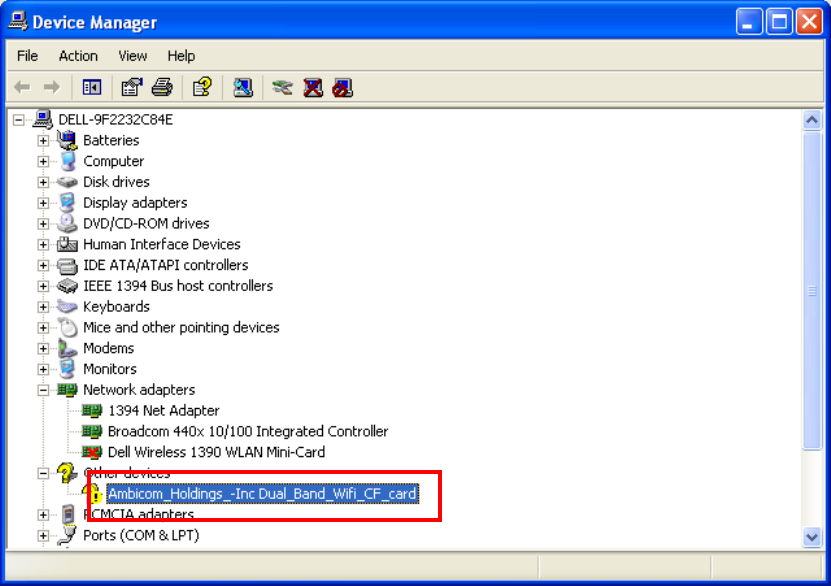
Humidity:20%‐95%
Certification:FCC,IC
2. Installation Procedure
Note1: Please notify if the desktop or laptop PC include the PCMCIA interface or CF
interface.
Note2: Please notify if the CF card is installed in the desktop or laptop PC.
2.1 Open the device manager
a. Press right button and select “Management” to the Computer Management.
b. Select the device management to open it, which is showed as follows:
2.2 Install the driver
a. Press the left button on the PCMCIA interface to show all PCMICA devices.
b. Press the right button on the “Ambicom_Holdings –Inc
dual_Band_Wifi_CF_card” and select “Modify Driver”.
c. Please refer the figure 1 to figure 12 and follow the instruction of the Wizard to
complete the driver installation.
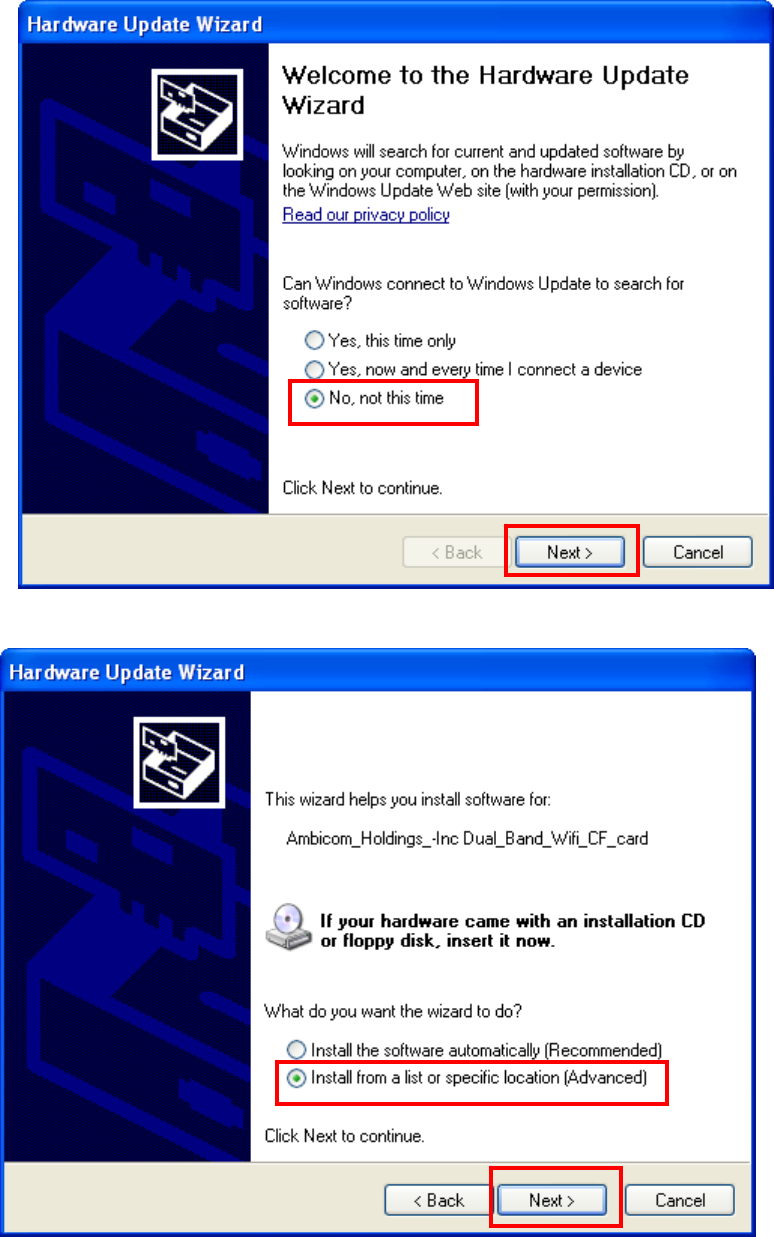
Figure 1
Figure 2
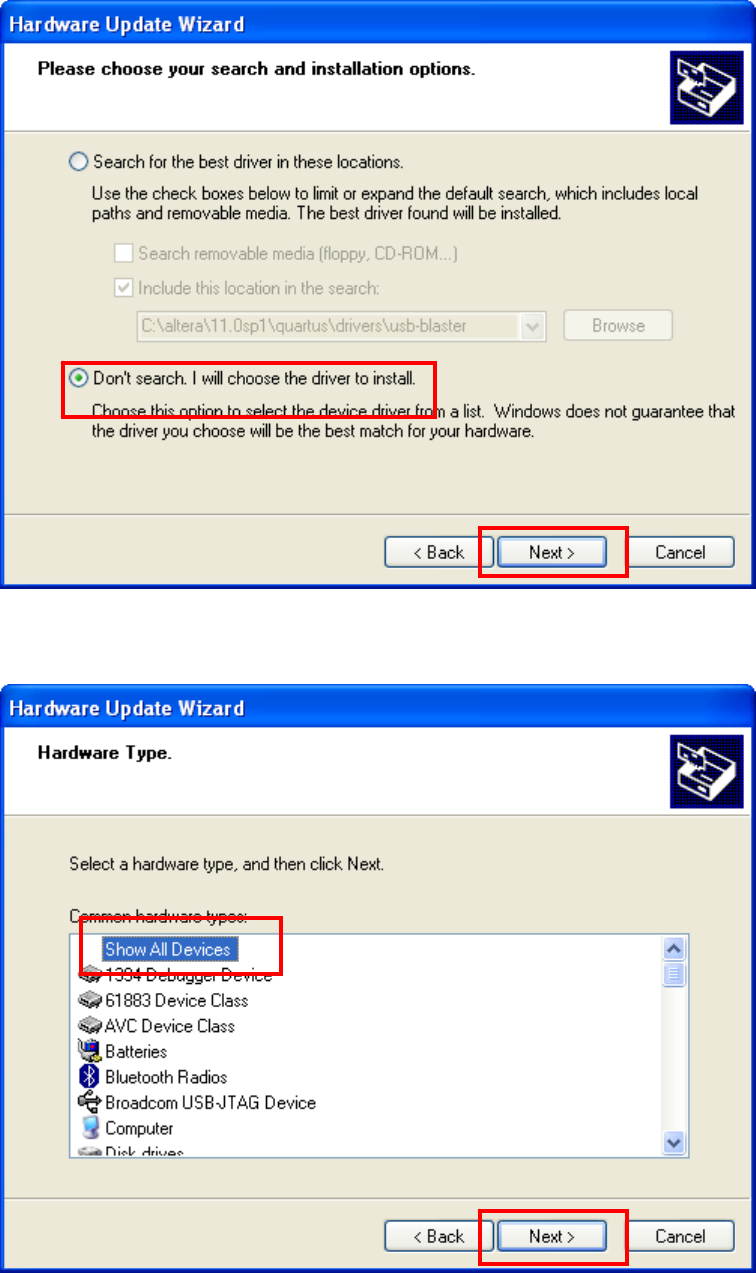
Figure 3
Figure 4
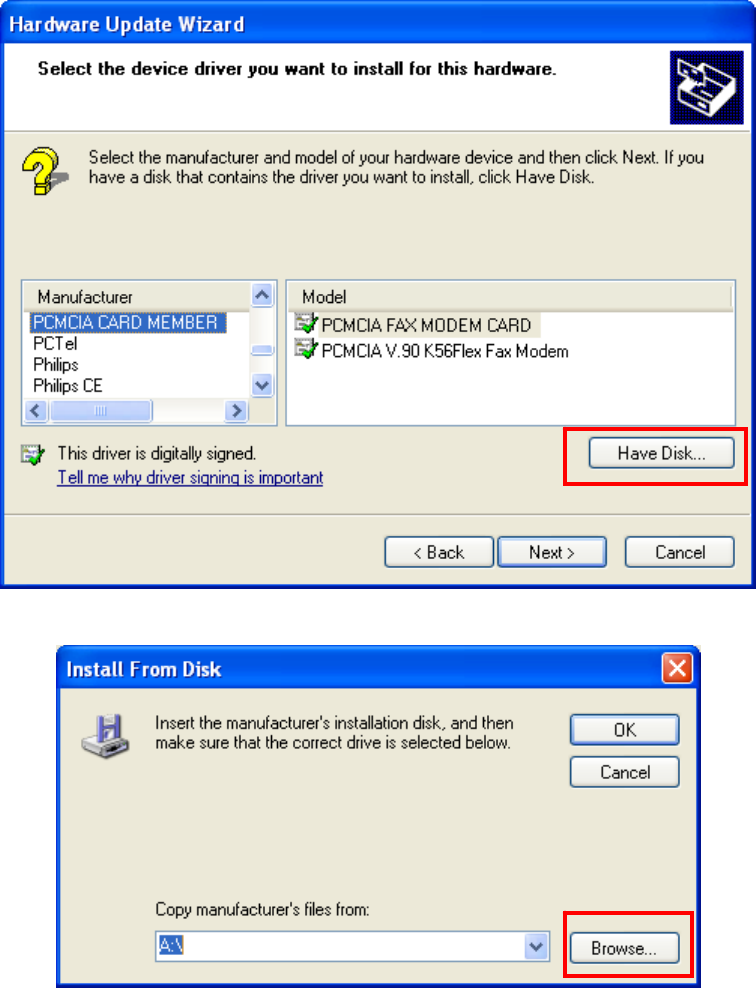
Figure 5
Figure 6
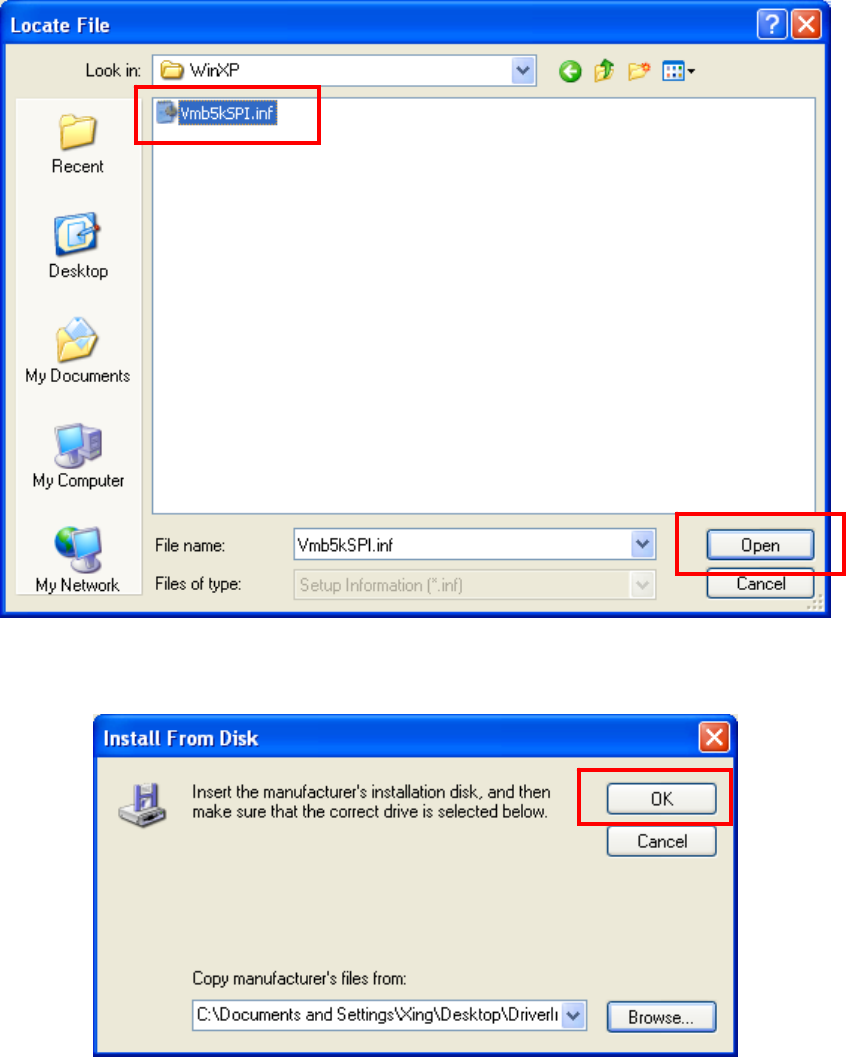
Figure 7
Figure 8
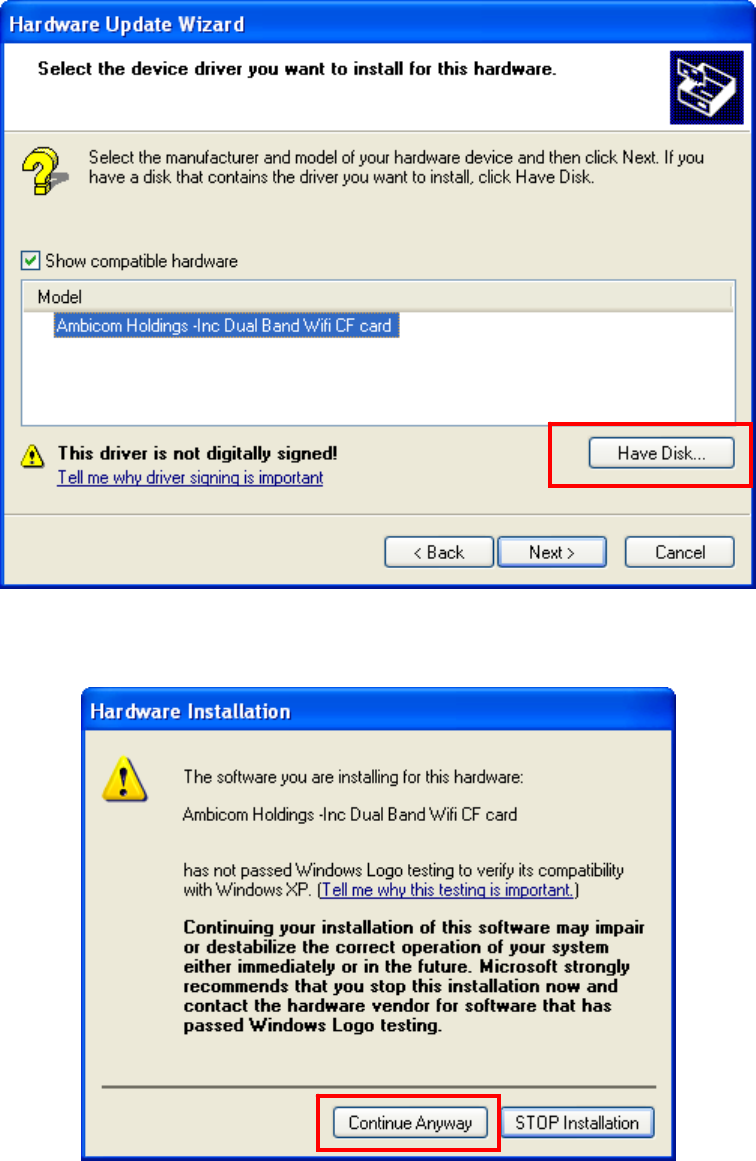
Figure 9
Figure 10
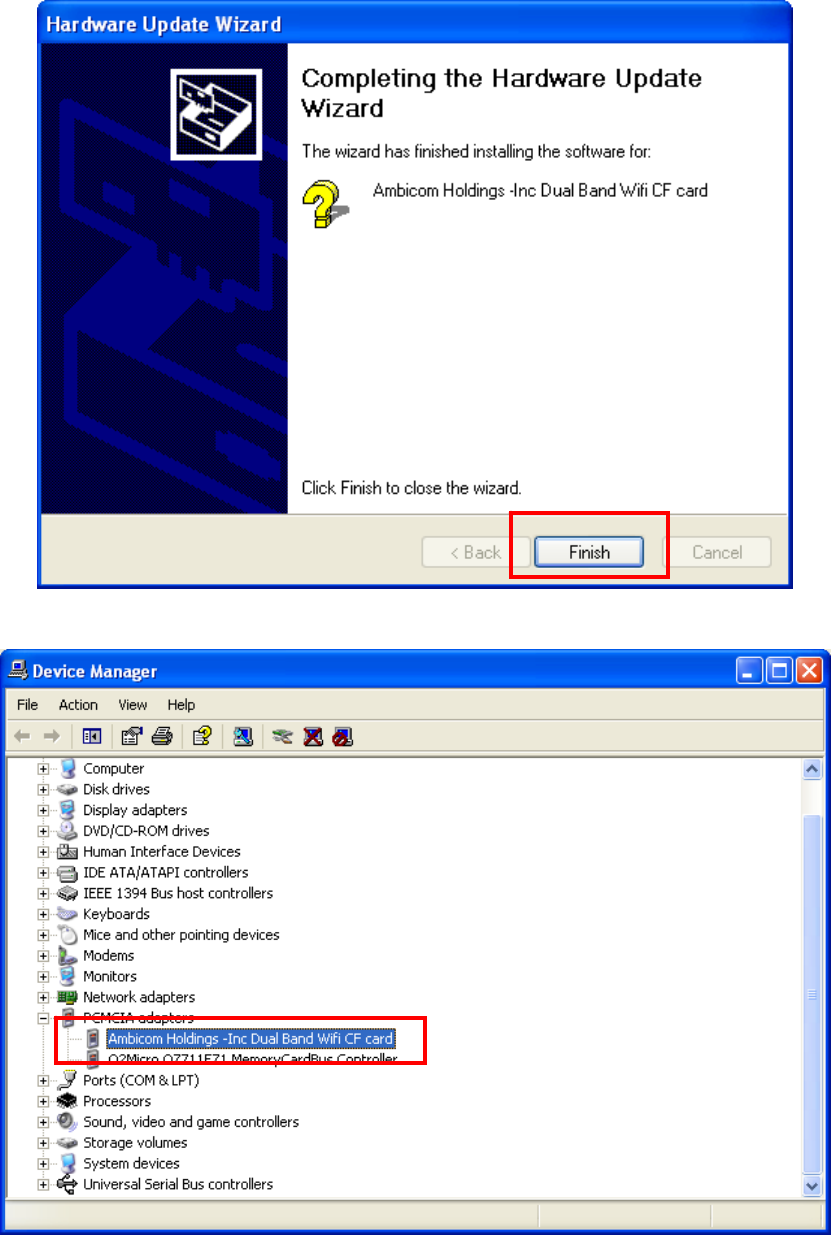
Figure 11
Figure 12
3 Application SoftwareandDataTransfer
3.1 Install RSeries WifiConfigure.exe
a. The PC has to be installed .Net 3.5 framework before run WifiConfigure.exe
b. Copy the WifiConfigure.exe in the CD to your PC.
3.2 Data Transfer
a. Please refer the figure 13 to fill the setting
b. Select DHCP or Static
c. If you select Static, you have to key in the IP address in “Local IP Address”
d. Check “Use DNS” and fill the IP address of DNS server to the “Primary
DNS” and “Secondary DNS”
e. In Wifi Radio of Wifi Setting, select “b/g/n (2.4GHz)” or “a/n (5GHz)
f. Enter a SSID you want to join in “Network Profile 1”.
g. Enter the Server IP and Server port in Defib History Transfer.
h. Enter the port number of the Upload Server
i. In network connection, select “Network Profile 1” to connect the upload
server via “Network Profile 1”.
j. If the connection is OK, the “File Transfer” will enable without any symbol.
k. Press the “File Transfer” to upload file.
Figure 13
Federal Communication Commission Interference Statement
This device complies with Part 15 of the FCC Rules. Operation is subject to
the following two conditions: (1) This device may not cause harmful
interference, and (2) this device must accept any interference received,
including interference that may cause undesired operation.
This equipment has been tested and found to comply with the limits for a
Class B digital device, pursuant to Part 15 of the FCC Rules. These limits
are designed to provide reasonable protection against harmful interference in a
residential installation. This equipment generates, uses and can radiate radio
frequency energy and, if not installed and used in accordance with the
instructions, may cause harmful interference to radio communications.
However, there is no guarantee that interference will not occur in a particular
installation. If this equipment does cause harmful interference to radio or
television reception, which can be determined by turning the equipment off
and on, the user is encouraged to try to correct the interference by one of the
following measures:
- Reorient or relocate the receiving antenna.
- Increase the separation between the equipment and receiver.
- Connect the equipment into an outlet on a circuit different from that
to which the receiver is connected.
- Consult the dealer or an experienced radio/TV technician for help.
FCC Caution: Any changes or modifications not expressly approved by the
party responsible for compliance could void the user's authority to operate this
equipment.
This transmitter must not be co-located or operating in conjunction with any
other antenna or transmitter.
Operations in the 5.15-5.25GHz band are restricted to indoor usage only.
Radiation Exposure Statement:
This equipment complies with FCC radiation exposure limits set forth for an
uncontrolled environment. This equipment should be installed and operated
with minimum distance 20cm between the radiator & your body.

This device is intended only for OEM integrators under the following conditions:
1) The antenna must be installed such that 20 cm is maintained between the
antenna and users, and
2) The transmitter module may not be co-located with any other transmitter
or antenna.
As long as 2 conditions above are met, further transmitter test will not be
required. However, the OEM integrator is still responsible for testing their
end-product for any additional compliance requirements required with this
module installed
IMPORTANT NOTE: In the event that these conditions can not be met (for
example certain laptop configurations or co-location with another transmitter),
then the FCC authorization is no longer considered valid and the FCC ID can
not be used on the final product. In these circumstances, the OEM integrator
will be responsible for re-evaluating the end product (including the transmitter)
and obtaining a separate FCC authorization.
End Product Labeling
This transmitter module is authorized only for use in device where the antenna
may be installed such that 20 cm may be maintained between the antenna and
users. The final end product must be labeled in a visible area with the following:
“Contains FCC ID: ZKP-RDC001. The grantee's FCC ID can be used only when
all FCC compliance requirements are met.
Manual Information To the End User
The OEM integrator has to be aware not to provide information to the end user
regarding how to install or remove this RF module in the user’s manual of the
end product which integrates this module.
The end user manual shall include all required regulatory information/warning as
show in this manual.